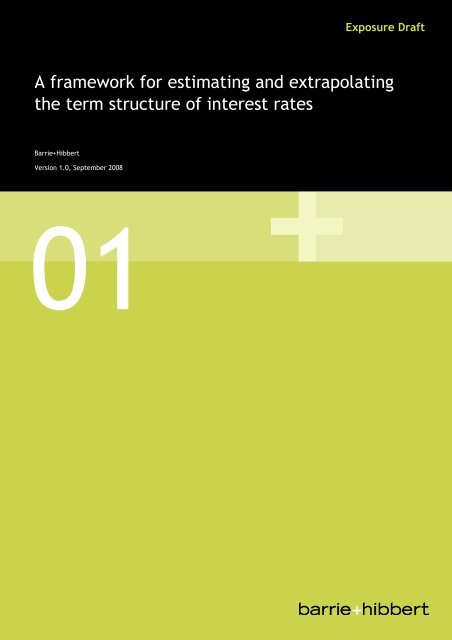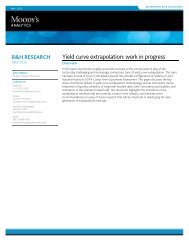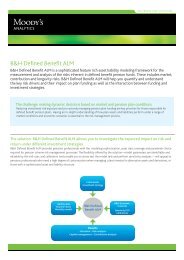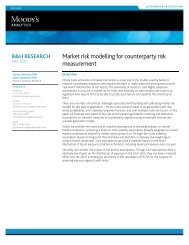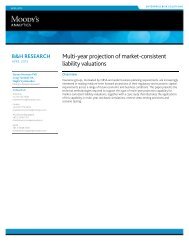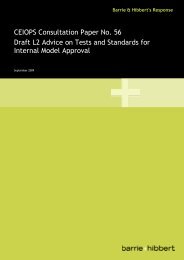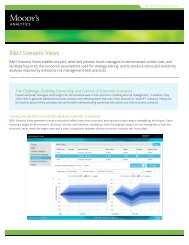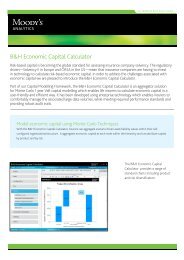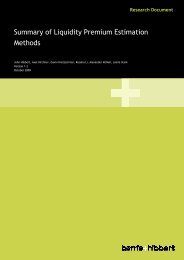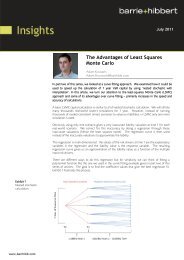A Framework for Estimating and Extrapolating the ... - Barrie & Hibbert
A Framework for Estimating and Extrapolating the ... - Barrie & Hibbert
A Framework for Estimating and Extrapolating the ... - Barrie & Hibbert
You also want an ePaper? Increase the reach of your titles
YUMPU automatically turns print PDFs into web optimized ePapers that Google loves.
A framework Yield <strong>for</strong> Curve Extrapolation estimating <strong>and</strong> long term nominal <strong>and</strong> interest extrapolating<br />
rate target settingv Yield Curve<br />
Extrapolation <strong>and</strong> long term nominal interest rate target setting<br />
<strong>the</strong> term structure of interest rates<br />
<strong>Barrie</strong>+<strong>Hibbert</strong><br />
Version 1.0, September 2008<br />
01<br />
Exposure Draft<br />
A framework <strong>for</strong> estimating <strong>and</strong> extrapolating <strong>the</strong> term structure of interest rates<br />
Version , September 2008 Page
Contents<br />
Executive summary ............................................................................................. 3<br />
1 Overview of <strong>the</strong> problem <strong>and</strong> our general approach ................................................ 5<br />
2 Yield curve interpolation <strong>and</strong> extrapolation .......................................................... 6<br />
2.1 General principles ............................................................................... 6<br />
2.2 Interpolation ..................................................................................... 6<br />
2.3 Fitting market swap rates <strong>and</strong> bond prices ................................................. 6<br />
2.4 Extrapolation ..................................................................................... 8<br />
3 Assumptions <strong>for</strong> <strong>the</strong> long-term <strong>for</strong>ward interest rate <strong>and</strong> extrapolation path ................. 9<br />
3.1 General principles ............................................................................... 9<br />
3.2 Methodology <strong>for</strong> setting an unconditional <strong>for</strong>ward interest rate ....................... 9<br />
3.3 Targets <strong>for</strong> a global unconditional nominal <strong>for</strong>ward rate ............................... 10<br />
4 Next Steps & Comments ................................................................................. 11<br />
A framework <strong>for</strong> estimating <strong>and</strong> extrapolating <strong>the</strong> term structure of interest rates<br />
Version , September 2008 Page 2
Executive summary<br />
Is <strong>the</strong>re any more fundamental valuation challenge than placing a value on a known cash flow at some time in<br />
<strong>the</strong> future? Risk-free yield curves are <strong>the</strong> basic building blocks <strong>for</strong> <strong>the</strong> valuation of future financial claims <strong>and</strong><br />
long-term risk management work. Despite <strong>the</strong>ir fundamental importance, it turns out that measuring <strong>and</strong><br />
estimating suitable risk-free interest rates presents some major challenges <strong>for</strong> analysts. In highly-developed<br />
fixed income markets we may be able to observe bonds or interest rate swap contracts with maturities of up<br />
to 50 years. In less developed markets liquid bond quotations might be limited to only a few years. In<br />
exceptional circumstances <strong>the</strong>re may be no traded risk-free instruments at all. Of course, <strong>the</strong> liabilities of<br />
long-term financial institutions frequently extend beyond <strong>the</strong> term of available market instruments. In order to<br />
value <strong>the</strong>se ultra long-term claims <strong>and</strong> assess risk, practitioners must extrapolate yield curves to generate a<br />
set of „pseudo-prices‟ <strong>for</strong> <strong>the</strong> assumed, inferred prices of discount bonds beyond <strong>the</strong> term of <strong>the</strong> longest<br />
available traded cash flow. A good yield curve estimation method must deliver extrapolated curves that are<br />
credible at a single point in time <strong>and</strong> where changes over time in extrapolated rates can be justified.<br />
This Exposure Draft summarises <strong>the</strong> methods to be applied in yield curve construction work by <strong>Barrie</strong> &<br />
<strong>Hibbert</strong> from 30 th September 2008. Fur<strong>the</strong>r details of our yield curve construction methods can be found in<br />
two documents which have been reviewed in an earlier draft <strong>for</strong>m by <strong>the</strong> Technical Advisory Panel 1 :<br />
1. „Calibration Methods - Fitting <strong>the</strong> yield curve: Spline interpolation <strong>and</strong> Nelson-Siegel extrapolation‟,<br />
September 2008.<br />
2. „Calibration Methods - Interest rate calibration: How to set long-term interest rates in <strong>the</strong> absence of<br />
market prices‟, September 2008.<br />
All of <strong>the</strong>se documents will be reviewed at <strong>the</strong> next meeting of <strong>the</strong> Technical Advisory Panel (currently<br />
scheduled <strong>for</strong> November 18 th 2008) alongside any comments received from clients <strong>and</strong> o<strong>the</strong>r interested<br />
parties be<strong>for</strong>e end-October 2008. Following this meeting, ei<strong>the</strong>r this Exposure Draft will re re-issued with<br />
amendments or published in <strong>the</strong> <strong>for</strong>m of a final Statement of Practice.<br />
Note <strong>the</strong> following:<br />
Yield curves <strong>for</strong> all currencies <strong>for</strong> which we provide calibrations are generated to a st<strong>and</strong>ard term of<br />
120 years.<br />
Yield curves can be represented in various ways – as a set of coupon yields, par yields, spot rates or<br />
<strong>for</strong>ward interest rates. We could choose to work with any of <strong>the</strong>se but <strong>for</strong> <strong>the</strong> purpose of this<br />
Exposure Draft we choose to work with continuously-compounded (log) <strong>for</strong>ward interest rates.<br />
Note that any set of <strong>for</strong>ward interest rates will uniquely define a set of spot rates, discount bond<br />
prices <strong>and</strong> par or coupon yields.<br />
Yield curve construction work requires completing two fundamental tasks. First, collating market data <strong>and</strong><br />
fitting a continuous curve to <strong>the</strong> term of <strong>the</strong> longest available market instrument. Second, we must<br />
extrapolate from <strong>the</strong> longest available market data towards some long-term assumption <strong>for</strong> <strong>for</strong>ward interest<br />
rates. Since we aim to generate yield curves to a term of 120 years, this second task is required <strong>for</strong> any<br />
currency.<br />
Regulators <strong>and</strong> policymakers have tackled <strong>the</strong>se tasks in different ways. For example, <strong>the</strong> CFO Forum<br />
establishes a general principle by saying that yield curves “should be extended using an appropriate<br />
methodology”. In <strong>the</strong> QIS4 technical guidance <strong>for</strong> Solvency II yield curve “interpolations <strong>and</strong> extrapolations<br />
are based on <strong>the</strong> assumption that <strong>for</strong>wards are constant”. Bitter experience of dealing with worldwide yield<br />
curves suggests that, whilst simple rules will work fine at some times <strong>and</strong> in some places, <strong>the</strong>ir universal<br />
application produces results that we cannot justify. Note that our proposed method does not preclude <strong>the</strong><br />
1 Fur<strong>the</strong>r details of <strong>the</strong> Technical Advisory Panel‟s objectives <strong>and</strong> working practices can be found on <strong>the</strong> <strong>Barrie</strong> + <strong>Hibbert</strong><br />
web site at http://www.barrhibb.com/index.php/technical_advisory_panel<br />
A framework <strong>for</strong> estimating <strong>and</strong> extrapolating <strong>the</strong> term structure of interest rates<br />
Version , September 2008 Page 3
application of a simpler rule; an analyst can replace our extrapolated estimates with ruled-based values. Our<br />
method is aimed at simply giving our best answer to <strong>the</strong> questions posed above.<br />
The first task requires a methodology <strong>for</strong> market data selection <strong>and</strong> <strong>for</strong> fitting <strong>for</strong>ward interest rates which are<br />
both smooth <strong>and</strong> exhibit credible stability through time. Fur<strong>the</strong>r, we believe that a rational method should<br />
deliver <strong>for</strong>ward rate changes where variability declines with maturity. Our proposed method involves fitting a<br />
smooth curve (a „regression spline‟) through a small number of „knot‟ points in order to simultaneously fit <strong>the</strong><br />
observed data closely <strong>and</strong> meet <strong>the</strong> smoothness criteria. Fur<strong>the</strong>r we propose to restrict <strong>the</strong> gradient (<strong>and</strong><br />
variability) of <strong>the</strong> longest observed market <strong>for</strong>ward rates be<strong>for</strong>e extrapolating towards an unconditional<br />
<strong>for</strong>ward rate target using <strong>the</strong> well-known Nelson-Siegel methodology 2 .<br />
The extrapolation requires us to answer two questions concerning how unobservable „pseudo‟ <strong>for</strong>ward rates<br />
might be expected to be determined beyond <strong>the</strong> term of available market data.<br />
First, we must set an unconditional (i.e. very long term assumption) <strong>for</strong> <strong>for</strong>ward rates based on longterm<br />
expectations <strong>for</strong> <strong>the</strong> components of <strong>for</strong>ward interest rates: <strong>the</strong> long-term real rate of interest,<br />
long-term inflation expectations, bond term premia <strong>and</strong> a technical „convexity‟ adjustment. Based<br />
on long term empirical data across 16 economies, we set a global unconditional nominal <strong>for</strong>ward<br />
interest rate of 5.3% <strong>and</strong> an unconditional nominal swap <strong>for</strong>ward rate of 5.7% consistent with a<br />
<strong>for</strong>ward swap spread assumption of 40bps at <strong>the</strong> end of September 2008.<br />
Second, we must define how quickly <strong>for</strong>ward rates move toward this unconditional assumption.<br />
Here, a path is chosen so that variation in <strong>for</strong>ward rates over time is matched (so far as this is<br />
possible) to a set of targets <strong>for</strong> <strong>for</strong>ward rate volatility that we judge to be reasonable. This variation<br />
decreases over time which is consistent with <strong>the</strong> view that unobservable ultra long-term <strong>for</strong>ward<br />
rates can be expected to be pretty stable.<br />
The chart below provides a high-level illustration of our new methods in a situation where market instruments<br />
are available to a maximum term of 10 years. In practice <strong>the</strong> available term of market data as well as <strong>the</strong> shape<br />
of curves <strong>and</strong> extrapolations will vary considerably across currencies <strong>and</strong> over time.<br />
Exhibit<br />
Yield curve extrapolation – <strong>the</strong> basic idea<br />
Interest Rate<br />
Market<br />
<strong>for</strong>ward<br />
rates<br />
Unconditional <strong>for</strong>ward rate assumption<br />
0 10 20 30 40 50 60 70 80 90 100 110 120<br />
Term to Maturity (years)<br />
2 Nelson, C. <strong>and</strong> A. Siegel (1987). Parsimonious Modelling of Yield Curves. Journal of Business 60-4, p473–489<br />
A framework <strong>for</strong> estimating <strong>and</strong> extrapolating <strong>the</strong> term structure of interest rates<br />
Version , September 2008 Page 4
1 Overview of <strong>the</strong> problem <strong>and</strong> our general<br />
approach<br />
Risk-free yield curves are <strong>the</strong> basic building blocks <strong>for</strong> <strong>the</strong> valuation of future financial claims <strong>and</strong> long-term<br />
risk management work. In highly-developed fixed income markets we may be able to observe bonds or<br />
interest rate swap contracts with maturities of up to 50 years. In less developed markets liquid bond<br />
quotations might be limited to only a few years. In exceptional circumstances <strong>the</strong>re may be no traded riskfree<br />
instruments at all. Of course, <strong>the</strong> liabilities of long-term financial institutions often extend beyond <strong>the</strong><br />
term of available market instruments. In order to value <strong>the</strong>se ultra long-term claims <strong>and</strong> assess risk,<br />
practitioners will extrapolate yield curves to generate a set of „pseudo-prices‟ <strong>for</strong> <strong>the</strong> assumed, inferred prices<br />
of discount bonds beyond <strong>the</strong> term of <strong>the</strong> longest available traded cash flow. In <strong>Barrie</strong> & <strong>Hibbert</strong>‟s yield curve<br />
calibration work, extrapolations are per<strong>for</strong>med to a st<strong>and</strong>ard term of 120 years.<br />
The purpose of this Exposure Draft (ED) is to document <strong>the</strong> specific practices to be applied in B+H‟s work.<br />
Our aim is to codify practice in this area so far as possible. Prior to June 2008 our practice was to extrapolate<br />
yields from existing market data without explicit targets <strong>for</strong> <strong>the</strong> behaviour of very long-term <strong>for</strong>ward rates.<br />
The procedures set out in this ED modify our working practices to use economic fundamentals to „anchor‟<br />
unobservable long-term yields. Changing our methodology will have an impact on <strong>the</strong> market-consistent <strong>and</strong><br />
real-world interest rate calibrations.<br />
Interest rates at <strong>the</strong> long (untraded) end of <strong>the</strong> curve <strong>and</strong> changes in those rates can have a material impact<br />
on value <strong>and</strong> risk capital calculations <strong>for</strong> long-term financial institutions. Fur<strong>the</strong>rmore, spurious variation in<br />
<strong>the</strong>se yields can feed through to give material balance sheet <strong>and</strong> valuation variation. With this in mind it<br />
becomes extremely important to develop a robust yield curve construction method: one which reflects (to<br />
some degree) current market conditions <strong>and</strong> empirical views of long rate volatility, while simultaneously<br />
displaying adequate stability. We aim to answer <strong>the</strong> following questions:<br />
How to interpolate a yield curve with discontinuous market data? In <strong>the</strong>ory, a <strong>for</strong>ward rate curve<br />
should be a smooth. The interesting question is „How smooth?‟ In <strong>the</strong> real world, available government<br />
bond prices <strong>and</strong> swap rates from liquid markets are not quoted across a continuous term structure.<br />
Variations in issue size <strong>and</strong> liquidity <strong>and</strong> o<strong>the</strong>r bond-specific factors mean observed yield curves can<br />
look quite „lumpy‟. A method is required to specify how to join up sparse market rates <strong>and</strong> impose an<br />
appropriate degree of smoothness.<br />
How to extrapolate <strong>the</strong> yield curve to terms where <strong>the</strong>re are no liquid traded risk free instruments?<br />
What is a suitable target <strong>for</strong> <strong>the</strong> <strong>for</strong>ward interest at a long-term horizon? To extrapolate beyond traded<br />
maturities, we need to set an assumption <strong>for</strong> <strong>the</strong> unconditional <strong>for</strong>ward interest rate. Should we simply<br />
use <strong>the</strong> average of empirical data or use financial economic <strong>the</strong>ory to justify an assumption? A sound<br />
methodology to „anchor‟ a relatively consistent <strong>and</strong> stable long term conditional target is desirable.<br />
Should unconditional <strong>for</strong>ward rate assumptions vary significantly across economies? It is widely<br />
believed that short-term interest rates of certain currencies include a risk premium. Can we justify<br />
permanent differences between economies <strong>for</strong> any of <strong>the</strong> components that make up <strong>the</strong> unconditional<br />
<strong>for</strong>ward rate: expectations <strong>for</strong> real interest rates, inflation, risk premia <strong>and</strong> convexity?<br />
These are not simple questions. Regulators <strong>and</strong> policymakers have addressed <strong>the</strong>m in different ways. For<br />
example, <strong>the</strong> CFO Forum establishes a general principle by saying that yield curves “should be extended<br />
using an appropriate methodology”. They <strong>the</strong>n offer some example methods which we believe will be<br />
appropriate in some circumstances but fail elsewhere 3 . In <strong>the</strong> QIS4 technical guidance <strong>for</strong> Solvency II yield<br />
curve “interpolations <strong>and</strong> extrapolations are based on <strong>the</strong> assumption that <strong>for</strong>wards are constant”. Bitter<br />
experience of dealing with worldwide yield curves suggests that, while this simple rule will work fine at some<br />
times <strong>and</strong> in some places, its universal application would produce results that we cannot justify. It is also<br />
important to note that where a regulator or convention prescribes a simple extrapolation rule our proposed<br />
method does not preclude it; an analyst can replace our extrapolated estimates with ruled-based values. Our<br />
method is aimed at simply giving our best answer to <strong>the</strong> questions posed above.<br />
3 CFO Forum: "Market Consistent Embedded Value Principles", June 2008<br />
A framework <strong>for</strong> estimating <strong>and</strong> extrapolating <strong>the</strong> term structure of interest rates<br />
Version , September 2008 Page 5
2 Yield curve interpolation <strong>and</strong> extrapolation<br />
2.1 General principles<br />
We define some general properties which we believe are desirable properties <strong>for</strong> <strong>the</strong> yield curves we will<br />
construct:<br />
1. Where a liquid market exists <strong>the</strong> yield curve should accurately price that market.<br />
2. The (<strong>for</strong>ward rate) curve should be continuous.<br />
3. The (<strong>for</strong>ward rate) curve should be smooth. That is, its first derivative should be continuous.<br />
4. On average, <strong>the</strong> variability of long-term (<strong>for</strong>ward) interest rates should be lower than shorter term<br />
(<strong>for</strong>ward) rates.<br />
2.2 Interpolation<br />
We fit <strong>the</strong> market bond data <strong>and</strong> swap data using a regression spline technique. We fit a natural cubic spline<br />
to <strong>the</strong> instantaneous <strong>for</strong>ward interest rate curve <strong>and</strong> calculate <strong>the</strong> corresponding zero coupon bond prices by:<br />
Where is <strong>the</strong> price of a zero coupon bond with maturity <strong>and</strong> are <strong>the</strong> set of instantaneous<br />
<strong>for</strong>ward rates. With a set of zero coupon bonds we can evaluate swap rates <strong>and</strong> bond prices <strong>and</strong> compare<br />
with <strong>the</strong> market. We adjust <strong>the</strong> points of <strong>the</strong> spline in order to alter <strong>the</strong> <strong>for</strong>ward rate curve <strong>and</strong> achieve better<br />
agreement with <strong>the</strong> market data. These points allow us to pivot <strong>the</strong> curve so as to obtain a close fit <strong>and</strong> are<br />
known as „knot-points‟. It is possible to fit a spline through many knot-points. However, in practice a more<br />
credible curve (con<strong>for</strong>ming to our general principles) is produced by fitting through a smaller number of<br />
points (typically between 3 to 10) <strong>and</strong> accepting that a perfect fit may not be produced <strong>for</strong> individual points.<br />
Fur<strong>the</strong>rmore, a lower number of knot-points also helps to minimize oscillations in <strong>the</strong> fitted curve through<br />
time.<br />
2.3 Fitting market swap rates <strong>and</strong> bond prices<br />
In practice, we use two types of market data to specify <strong>the</strong> yield curve: bond price data or (swap) interest rate<br />
data. In <strong>the</strong> market, <strong>the</strong> swap rate is normally quoted in <strong>the</strong> <strong>for</strong>m of a par yield <strong>for</strong> a given maturity.<br />
Government bond data can be quoted in <strong>the</strong> <strong>for</strong>m of ei<strong>the</strong>r bond yields or market bond prices. There<strong>for</strong>e,<br />
instead of defining our approach <strong>for</strong> swap rates <strong>and</strong> bond prices directly, we define it <strong>for</strong> market yields <strong>and</strong><br />
price data.<br />
When fitting <strong>the</strong> market yields we adjust <strong>the</strong> <strong>for</strong>ward rate at <strong>the</strong> spline knot-points to minimise<br />
Where is <strong>the</strong> market yield, is <strong>the</strong> yield obtained from <strong>the</strong> fitted <strong>for</strong>ward curve <strong>and</strong> is <strong>the</strong> number of<br />
market data points. All market data points are weighted equally.<br />
When fitting <strong>the</strong> market prices we minimise<br />
A framework <strong>for</strong> estimating <strong>and</strong> extrapolating <strong>the</strong> term structure of interest rates<br />
Version , September 2008 Page 6<br />
(1)<br />
(2)<br />
(3)
Where is <strong>the</strong> market price, is <strong>the</strong> price obtained from <strong>the</strong> splined <strong>for</strong>ward curve, is <strong>the</strong> duration <strong>and</strong><br />
is <strong>the</strong> number of market data points. Here, we weight <strong>the</strong> objective function by <strong>the</strong> bond duration. Since<br />
<strong>the</strong> sensitivity of bond prices will vary with bond duration, we have weighted prices using <strong>the</strong>ir duration to<br />
give approximately <strong>the</strong> same weighting strategy as <strong>for</strong> yields. Without such weighting <strong>the</strong> fit to <strong>the</strong> market<br />
prices will tend to suffer <strong>for</strong> short-term maturities, especially when a smoothing constraint is applied.<br />
When interpolating <strong>the</strong> swap <strong>and</strong> government rate curve, we apply a smoothing constraint to dampen <strong>the</strong><br />
volatility of <strong>the</strong> <strong>for</strong>ward rate curve at long maturities.<br />
Where is a constant parameter that specifies <strong>the</strong> strength of <strong>the</strong> smoothing constraint. We only employ<br />
this smoothing at <strong>the</strong> end of <strong>the</strong> <strong>for</strong>ward curve <strong>and</strong> which corresponds to <strong>the</strong> final 20% of <strong>the</strong><br />
available market data. Using a smoothness condition inevitably affects <strong>the</strong> quality of fit. We minimise <strong>the</strong><br />
gradient squared of <strong>the</strong> <strong>for</strong>ward curve whilst remaining approximately 5 bps from <strong>the</strong> bond market data <strong>and</strong> 2<br />
bps from <strong>the</strong> swap market data.<br />
Note that, were we not to apply this smoothing constraint, any extrapolation methodology which is<br />
constrained to be smooth at <strong>the</strong> longest market <strong>for</strong>ward rate, would produce increasing volatility in <strong>for</strong>ward<br />
rate volatility <strong>for</strong> some real-world yield curves which exhibit strong curvature at <strong>the</strong> long end. We believe this<br />
is largely a consequence of <strong>the</strong> difficulty of measuring long-term <strong>for</strong>ward rates <strong>and</strong> impose what we believe is<br />
an economically rational constraint on <strong>for</strong>ward rate behaviour.<br />
A framework <strong>for</strong> estimating <strong>and</strong> extrapolating <strong>the</strong> term structure of interest rates<br />
Version , September 2008 Page 7<br />
,<br />
(4)
2.4 Extrapolation<br />
Extrapolation requires answering two questions about <strong>the</strong> path of <strong>for</strong>ward interest rates beyond <strong>the</strong> longest<br />
market data point. Firstly, what is an appropriate assumption <strong>for</strong> <strong>the</strong> infinite-maturity, unconditional <strong>for</strong>ward<br />
rate of interest? Secondly, what path is chosen between <strong>the</strong> longest (smoo<strong>the</strong>d) market <strong>for</strong>ward rate <strong>and</strong> this<br />
ultra long-term rate? In particular, <strong>the</strong> analyst needs to determine <strong>the</strong> speed at which <strong>the</strong> extrapolated<br />
<strong>for</strong>ward rate tends towards <strong>the</strong> long-term asymptote.<br />
We extrapolate <strong>the</strong> <strong>for</strong>ward curve from <strong>the</strong> end of <strong>the</strong> market data to an unconditional <strong>for</strong>ward rate target<br />
using <strong>the</strong> Nelson-Siegel parametric <strong>for</strong>m:<br />
Here corresponds to <strong>the</strong> unconditional <strong>for</strong>ward rate, is a free parameter which we can use to control <strong>the</strong><br />
speed of convergence <strong>and</strong> <strong>and</strong> can be specified by matching <strong>the</strong> value <strong>and</strong> derivative of <strong>the</strong> curve at<br />
<strong>the</strong> last market data point. The terminal market maturity is denoted by . We fix <strong>the</strong> parameter by<br />
constraining <strong>the</strong> st<strong>and</strong>ard deviation of extrapolated <strong>for</strong>ward rates to meet a certain target at a particular<br />
horizon. Let us look at this in more detail.<br />
The choice of parameter controls <strong>the</strong> variation through time in extrapolated <strong>for</strong>ward rates. A high value <strong>for</strong><br />
will lead to faster convergence of <strong>the</strong> <strong>for</strong>ward curve to <strong>the</strong> unconditional <strong>for</strong>ward rate target, so <strong>the</strong> <strong>for</strong>ward<br />
rate volatility will decrease. A low value <strong>for</strong> will lead to slower convergence to <strong>the</strong> unconditional target so<br />
<strong>for</strong>ward rate variation will be higher. Here, <strong>for</strong>ward rate volatility at <strong>the</strong> longest market data point will be<br />
transmitted to adjacent maturities <strong>and</strong> only decay slowly. We can set <strong>the</strong> value of by estimating <strong>the</strong> <strong>for</strong>ward<br />
rate volatility term structure using historical <strong>for</strong>ward rate data <strong>and</strong> market data sources. This task turns out to<br />
be difficult. Our approach <strong>and</strong> conclusions on suitable assumptions <strong>for</strong> <strong>for</strong>ward rate volatility at various<br />
horizons are set out in detail in our <strong>for</strong>thcoming report “How to construct a volatility term-structure of interest<br />
rates in <strong>the</strong> absence of market prices” (Z. Liu, 2008). A summary of <strong>for</strong>ward rate volatility targets is shown<br />
below in exhibit 2.1.<br />
Initially (i.e. at September 2008) we use a value of to be consistent with <strong>the</strong> target <strong>for</strong>ward rate<br />
volatility decay shown below.<br />
Exhibit 2.1<br />
Volatility targets <strong>for</strong> <strong>the</strong> year-to-year proportional changes of instantaneous <strong>for</strong>ward rates<br />
Maturity/years 1 5 10 15 30 60 120 Infinity<br />
vol: target 27.9 14.8 12.8 12.4 9.6 3.1 0. 2 0<br />
The following section explains how <strong>the</strong> unconditional <strong>for</strong>ward interest rate is chosen.<br />
A framework <strong>for</strong> estimating <strong>and</strong> extrapolating <strong>the</strong> term structure of interest rates<br />
Version , September 2008 Page 8<br />
(5)
3 Assumptions <strong>for</strong> <strong>the</strong> long-term <strong>for</strong>ward interest<br />
rate <strong>and</strong> extrapolation path<br />
3.1 General principles<br />
Similar to yield curve construction, we set out some general principles <strong>for</strong> estimation of <strong>the</strong> unconditional<br />
nominal <strong>for</strong>ward rate.<br />
Stability: The unconditional nominal <strong>for</strong>ward rate cannot be materially affected by short term<br />
economic changes.<br />
Consistency: If <strong>the</strong> long-term <strong>for</strong>ward rate is approached at some very long-term horizon, we would<br />
expect this value to be broadly <strong>the</strong> same around <strong>the</strong> world.<br />
Simplicity: Whilst it is inherently difficult to estimate <strong>the</strong> long-term <strong>for</strong>ward interest rates, we aim to<br />
use a simple approach that is easy to underst<strong>and</strong> that can be applied to a large number of<br />
economies.<br />
3.2 Methodology <strong>for</strong> setting an unconditional <strong>for</strong>ward interest rate<br />
The long term (unconditional) nominal <strong>for</strong>ward interest rate is defined as <strong>the</strong> <strong>for</strong>ward interest rate <strong>for</strong> an<br />
infinite maturity. In practice, <strong>for</strong> <strong>the</strong> range of parameters we judge to be suitable, <strong>the</strong>re is a high degree of<br />
convergence in <strong>for</strong>ward rates over <strong>the</strong> typical 50-120 year horizon over which <strong>the</strong> methodology is used.<br />
No arbitrage argument can be used to show that <strong>the</strong> nominal long-term (unconditional) <strong>for</strong>ward interest rate<br />
(UFR) consists of four components:<br />
Long term nominal <strong>for</strong>ward interest rate = Real expected short-term interest rate<br />
+ Long term expected inflation<br />
+ Long term nominal term premium<br />
+ Long term nominal convexity effect<br />
In general, we have based our estimates <strong>for</strong> each component of <strong>the</strong> UFR on empirical data <strong>for</strong> countries with<br />
available long historical time-series of annual data. We construct each of <strong>the</strong> components of <strong>the</strong> long term<br />
nominal <strong>for</strong>ward rate using a weighting scheme of historical data that attributes a larger weight to more<br />
recent observations. Details of how we propose to estimate each of <strong>the</strong> components of <strong>the</strong> unconditional<br />
nominal <strong>for</strong>ward rate is set out in detail in <strong>the</strong> report „Calibration Methods - Interest rate calibration: How to<br />
set long-term interest rates in <strong>the</strong> absence of market prices‟.<br />
A framework <strong>for</strong> estimating <strong>and</strong> extrapolating <strong>the</strong> term structure of interest rates<br />
Version , September 2008 Page 9
3.3 Targets <strong>for</strong> a global unconditional nominal <strong>for</strong>ward rate<br />
Exhibit 3.1 summarises our assumptions <strong>for</strong> <strong>the</strong> unconditional nominal <strong>for</strong>ward rate at end-September2008.<br />
The unconditional nominal <strong>for</strong>ward rate is set at 5.3% comprised of an expected real cash rate of 1.8%,<br />
expected inflation of 2.4%, an unconditional term premium of 1.5% <strong>and</strong> a technical convexity adjustment of<br />
0.4%. All of <strong>the</strong>se estimates are based on slow-moving historical exponentially weighted averages with <strong>the</strong><br />
exception of expected inflation. Here, our estimate is weighted 80% towards a <strong>for</strong>ward-looking view derived<br />
from an average of central bank inflation targets.<br />
Exhibit 3.1<br />
Long-term nominal government <strong>and</strong> swap <strong>for</strong>ward interest rate<br />
Exhibit location: summary_tables.xls<br />
In <strong>the</strong> swap calibration we add an additional spread of 40bps to <strong>the</strong> long-term level of <strong>the</strong> unconditional<br />
<strong>for</strong>ward rate, giving a long-term unconditional <strong>for</strong>ward rate in <strong>the</strong> swap calibration of 5.7%. We plan to revise<br />
<strong>the</strong>se estimates in <strong>the</strong> first quarter each year. Our research provides more background on this assumption 4 . In<br />
summary we believe that <strong>the</strong>re are three possible explanations <strong>for</strong> this spread:<br />
i. Government bonds <strong>and</strong> <strong>the</strong> swap rare are referenced to different interest rates.<br />
ii. The term (risk) premia embedded in <strong>the</strong> government <strong>and</strong> swap rates are different.<br />
iii. If ei<strong>the</strong>r explanation is correct, <strong>the</strong> relative variance of <strong>the</strong> prices of <strong>the</strong> instruments may differ <strong>and</strong><br />
contribute to <strong>the</strong> spread.<br />
Finally, note that, while we add all of this spread to our estimate of <strong>the</strong> unconditional <strong>for</strong>ward rate in <strong>the</strong> swap<br />
calibration, we attribute only 20 bps to <strong>the</strong> long term real short rate.<br />
These assumptions are used <strong>for</strong> all economies where we currently construct yield-curves.<br />
4 See <strong>Barrie</strong>+<strong>Hibbert</strong> draft calibration note: „Underst<strong>and</strong>ing <strong>the</strong> long-term swap spread <strong>for</strong> real-world calibration‟. This<br />
note will be discussed with <strong>the</strong> TAP in Autumn 2008.<br />
A framework <strong>for</strong> estimating <strong>and</strong> extrapolating <strong>the</strong> term structure of interest rates<br />
Version , September 2008 Page 10
4 Next Steps & Comments<br />
This Exposure Draft summarises <strong>the</strong> methods to be applied in yield curve construction work by <strong>Barrie</strong> &<br />
<strong>Hibbert</strong> from 30 th September 2008. Fur<strong>the</strong>r details of our yield curve construction methods can be found in<br />
two documents which have been reviewed in an earlier draft <strong>for</strong>m by <strong>the</strong> Technical Advisory Panel:<br />
1. „Calibration Methods - Fitting <strong>the</strong> yield curve: Spline interpolation <strong>and</strong> Nelson-Siegel extrapolation‟,<br />
September 2008<br />
2. „Calibration Methods - Interest rate calibration: How to set long-term interest rates in <strong>the</strong> absence of<br />
market prices‟, September 2008.<br />
All of <strong>the</strong>se documents will be reviewed at <strong>the</strong> next meeting of <strong>the</strong> Technical Advisory Panel (currently<br />
scheduled <strong>for</strong> November 18 th 2008) alongside any comments received from clients <strong>and</strong> o<strong>the</strong>r interested<br />
parties be<strong>for</strong>e end-October 2008. Following this meeting, ei<strong>the</strong>r this Exposure Draft will re re-issued with<br />
amendments or published in <strong>the</strong> <strong>for</strong>m of a final Statement of Practice.<br />
Any comments should be sent using email to Ruosha.Li@barrhibb.com<br />
A framework <strong>for</strong> estimating <strong>and</strong> extrapolating <strong>the</strong> term structure of interest rates<br />
Version , September 2008 Page 11
Disclaimer<br />
Copyright 2008 <strong>Barrie</strong> & <strong>Hibbert</strong> Limited. All rights reserved. Reproduction in whole or in part is prohibited except by<br />
prior written permission of <strong>Barrie</strong> & <strong>Hibbert</strong> Limited (SC157210) registered in Scotl<strong>and</strong> at 7 Exchange Crescent,<br />
Conference Square, Edinburgh EH3 8RD, authorised <strong>and</strong> regulated by <strong>the</strong> Financial Services Authority. This document is<br />
intended to provide in<strong>for</strong>mation to Eligible Counterparties* <strong>and</strong>/or Professional Clients*. This document is not intended<br />
<strong>for</strong> Retail Customers*.<br />
* As defined in <strong>the</strong> Rules of <strong>the</strong> FSA<br />
The in<strong>for</strong>mation in this document is believed to be correct but cannot be guaranteed. All opinions <strong>and</strong> estimates included<br />
in this document constitute our judgment as of <strong>the</strong> date indicated <strong>and</strong> are subject to change without notice. Any opinions<br />
expressed do not constitute any <strong>for</strong>m of advice (including legal, tax <strong>and</strong>/or investment advice).<br />
This document is intended <strong>for</strong> in<strong>for</strong>mation purposes only <strong>and</strong> is not intended as an offer or recommendation to buy or sell<br />
securities. The <strong>Barrie</strong> & <strong>Hibbert</strong> group excludes all liability howsoever arising (o<strong>the</strong>r than liability which may not be<br />
limited or excluded at law) to any party <strong>for</strong> any loss resulting from any action taken as a result of <strong>the</strong> in<strong>for</strong>mation provided<br />
in this document. The <strong>Barrie</strong> & <strong>Hibbert</strong> group, its clients <strong>and</strong> officers may have a position or engage in transactions in any<br />
of <strong>the</strong> securities mentioned.<br />
Contact<br />
Head Office<br />
<strong>Barrie</strong> & <strong>Hibbert</strong> Ltd<br />
7 Exchange Crescent<br />
Conference Square<br />
Edinburgh<br />
EH3 8RD<br />
Tel: 0131 625 0203<br />
Fax: 0131 625 0215<br />
Please contact info@barrhibb.com<br />
EMEA Enquiries<br />
<strong>Barrie</strong> & <strong>Hibbert</strong> Ltd<br />
41 Lothbury<br />
London<br />
EC2R 7HG<br />
Tel: 0203 170 6145<br />
Fax: 0131 625 0215<br />
Please contact emea@barrhibb.com<br />
North America Enquiries<br />
<strong>Barrie</strong> & <strong>Hibbert</strong> Inc.<br />
40 Wall Street, 28th Floor<br />
New York,<br />
NY 10005<br />
Tel: 646-512-5750<br />
Fax: 646-512-5756<br />
Please contact us@barrhibb.com<br />
Asia Pacific Enquiries<br />
<strong>Barrie</strong> & <strong>Hibbert</strong> Asia Ltd<br />
Level 39, One Exchange Square<br />
8 Connaught Place<br />
Central Hong Kong<br />
Tel: +852-3101 7561<br />
Fax: +852-3101 7530<br />
Please contact asiapac@barrhibb.com<br />
<strong>Barrie</strong> & <strong>Hibbert</strong> Inc. 28th Floor, 40 Wall Street, New York <strong>and</strong> <strong>Barrie</strong> & <strong>Hibbert</strong> Asia Limited (company number 1240846)<br />
registered office, Level 39, One Exchange Square, 8 Connaught Place, Central Hong Kong, are both wholly owned<br />
subsidiaries of <strong>Barrie</strong> & <strong>Hibbert</strong> Limited.<br />
A framework <strong>for</strong> estimating <strong>and</strong> extrapolating <strong>the</strong> term structure of interest rates<br />
Version , September 2008 Page 12


